I loved the freedom of having a car on the island. The traffic was minimal if you don't count the troop of wild horse I came across meandering slowly up the road without a care in the world. Time didn't seem to matter that much on Easter Island, so I was happy to move along slowly following the horses until they decided it was time to let me go.
As I drove, I stumbled upon archaeological sites that were situated right beside the road. All of the sites had a simple chain or rope fence around them complimented by an information board. Some of these sites contained a Moai or two while many more were petroglyphs. You could walk right up to these fantastic carvings and often I had to stare at the sculpture for some time before vaguely making out a shape. The petroglyphs are not protected from the elements, and many are fading away to nothing but old rocks.
Usually, when I made a stop, I was the only one there so I could take all the time I want. On one such occasion, I was joined by five horses who casually walked into the area of the petroglyphs and started grazing. I could only wonder at the damage they cause to these ancient relics across the island.
On my third day on Easter Island, I decided to trek to the stone houses at Orongo ceremonial village used during the birdman era. These stone houses at Orongo are where families lived during the birdman competition ceremony to support their tribal representative.
I should perhaps explain the Birdman competition. A representative from each tribe was selected to compete against the other tribes on the island. The competitors would climb down a 250-metre craggy cliff face and swim out over a kilometre to the islet called Motu Nui, where they would have to retrieve a newly laid egg from the manutara bird, swim back and climb up the cliff again. The first competitor to return with an intact egg was declared the winner and would earn the privileges of the king for the next 12 months. The winner's tribe would also be the dominant tribe during the birdman's reign. He was also offered to choose for a wife one of the virgin girls from Ana O Keke ("Virgin Cave") where the girls had been trapped to obtain a white skin, which was considered a sign of beauty.
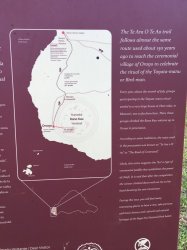
Vivero Plants Nursery is opposite Canabas Chrisophe where I started my trek to Orengo
Appears simple, doesn't it? Well no it is a gruelling and dangerous contest I couldn't believe how sheer the cliff was that the competitors had to climb/scramble down and I am sure many would have fallen to their deaths. The swim out to the inlet would have been hazardous as well as huge waves were rolling in and dashed against the inlet. Finding a newly laid egg may have been easy but getting it back to the top in one piece would have been a chore of skill and luck. I can imagine climbing down and swimming out to the inlet, stealing the egg swimming back and climbing again only to crack the egg short of the finish line. Now that would be a cruel ending.
I arrived at Orongo by taking the uphill hiking track that was situated just across the road from my accommodation. The path uphill was unpaved but generally easy to follow. The pathway led through some of the remaining vegetation on the island as I climbed higher I was afforded a great view of the island and in particular the airport. By chance, my climb coincided with the departure of the LATAM flight, and it was interesting to watch from such a vantage point.
After a hike that took around an hour, I arrived at Orongo. There were half a dozen cars in the carpark and the most tourists I had encountered away from the centre of the town. I climbed a few final stairs and stood in awe of what lay before me - the vast volcanic caldera called Rano Kau. Below Orongo on one side a 300-meter barren cliff face drops down to the ocean; on the other, a more-gentle but still very steep grassy slope leads down to a freshwater marsh inside the vast caldera. Rano Kau is one of only three freshwater locations on the island, and because of the two hundred meters high caldera, Rano Kau has its unique eco-system.
To the left of me was the stone village of Orango which contains 53 masonry houses that were restored in 1974. Historians believe that these houses that perch precariously upon the clifftop were only inhabited during the times of the birdman festival and for the rest of the year, they were unoccupied.
Approaching the entrance, you sign a book which is held by an attendant, and then you can wander through a small exhibit which explains the birdman contest and the stone houses. The paths are well marked, and you have to be aware not to wander off as you are walking along the top of a 300-metre drop. What amazed me most about these houses was the artistry and how small the entrance and roof was. The houses certainly didn't appear to be built for comfort.
All around the Orango clifftop are many petroglyphs many detailing the birdman contest. Scattered throughout the village are information boards that describe what you are looking at and explaining the Birdman contest. On more than one occasion I looked out to sea and wondered at these birdmen who clambered down the sheer cliff and plunged into the choppy ocean to swim out to a far away inlet to find a sooty terns egg and then swim and climb back to the top without breaking the egg. Both amazing and baffling.
Leaving the cliff top homes behind me, I once again went to look over the vast caldera and decided that before I leave Easter Island, I am going to travel to the opposite side of the caldera as I spied a faint trail heading off in that direction.
I made my way back down the hill easier now as it was downhill and arrived back at Christophe's tired but elated by what I had seen. After washing up, I jumped in the car and headed into town and had an excellent freshly caught local fish dinner.
Early the next morning I set off early to visit the most important archaeological site on Easter Island - Rano Raraku the site where 95% of the Moai were hewn from the stone found there. I arrived at the carpark the only vehicle there and paid a small fee at a ramshackle hut. There were also a few wooden buildings at the entrance that provided a few necessary facilities for tourists.
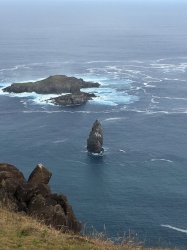
From the cliffs of Orengo the birdmen would swim to the farthest rocky outcrop
Once there you start walking and follow the trails and a few directions. As I was there early in the morning, I had the place to myself which was beautiful as I could take my time without the worry of hoards of tourists. That is one of the things I liked about Easter Island - the space and lack of people.
Rano Raraku is the resting place for 397 Moai. Some are standing buried in the ground to their upper chest while others are still in situ where they were being hewn for the rock. The largest Moai still lying in the living rock is almost 22 metres long and weighs an estimated 270 tonnes. Some of the Moai appear to have been abandoned as it became too challenging to hew the rock. One of the most interesting sights is the Tukuturi moai. It is bearded and is found in a kneeling posture which distinguishes it from almost every other moai on the island.
I walked around the hills of Rano Raraku for a couple of hours marvelling at the industry and to me the frivolity of carving these huge statues from the rock and then moving them many kilometres away to then bury them in the ground. It was only towards the end of my time that a few other tourists arrived.
My next stop was at Ahu Tongariki which is one kilometre from Rano Raraku, and it was here I found the largest ahu on Easter Island. The Moai here were toppled during the island's civil wars, and in the twentieth century, the ahu was swept inland by a tsunami. It has since been restored and has fifteen moai including an 86 tonne moai that was the heaviest ever erected on the island. One Moai still has the distinctive red topknot on its head that is fashioned from red volcanic scoria.
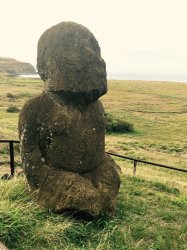
Tukituri Moai the only kneeling Moai on Easter Island
This is another fabulous site with the backdrop being sheer cliffs with waves pounding upon it and surf and foam being slung into the air. The Moai face inland stoic as usual. What a task it must have been to place these 15 upon their stone platform. I walked around the ahu several times looking at the Moai from every angle. What a unique experience and needless to say I was the only one there.
I drove back to my accommodation stopping on the way at the post office where for a small fee you can have an Easter Island Moai stamp placed in your passport. Nothing official of course and I am not sure if you are supposed to do such a thing to your passport, but I did, and now I have a very bold and unique Rapa Nui stamp adorning my passport.
I left the car at Christophe's and set off up the hill once again to Organo my mission was to circle the caldera. On reaching the viewpoint at the top, I set off in the opposite direction from the stone houses. Now, this wasn't a designated tourist destination or pathway. There was a vague track that often led through head-high grasses. Sometimes the path almost petered out, and I had to stop and search for the trail. The trail meandered over rocky outcrops that went precariously close to a 200-metre drop to the marshy bottom of the caldera.
It took me a little more than an hour to get to the gap in the caldera which once there I realised that I could go no further as it was a sheer drop off to the ocean on one side and the caldera on the other. I could see and wave to tourists on the other side that were visiting the stone houses of Organo they were probably wondering how in the hell I got to the other side.
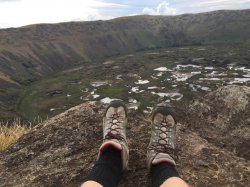
Lunch with a view. I trekked from the opposite side to where I am seated
Satisfied I sat down and pulled a sandwich from my backpack and content I ate my late lunch looking across the expanse of the caldera as well as out to see where I could see the birdman islet. My contentment soon disappeared when I realised that I now had to follow my tracks back the way I cam as well as making the long downhill journey back to my inviting bed. Sometimes I don't plan as well as I should.
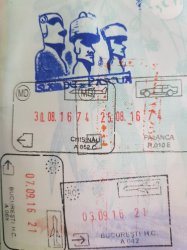
As I drove, I stumbled upon archaeological sites that were situated right beside the road. All of the sites had a simple chain or rope fence around them complimented by an information board. Some of these sites contained a Moai or two while many more were petroglyphs. You could walk right up to these fantastic carvings and often I had to stare at the sculpture for some time before vaguely making out a shape. The petroglyphs are not protected from the elements, and many are fading away to nothing but old rocks.
Usually, when I made a stop, I was the only one there so I could take all the time I want. On one such occasion, I was joined by five horses who casually walked into the area of the petroglyphs and started grazing. I could only wonder at the damage they cause to these ancient relics across the island.
On my third day on Easter Island, I decided to trek to the stone houses at Orongo ceremonial village used during the birdman era. These stone houses at Orongo are where families lived during the birdman competition ceremony to support their tribal representative.
I should perhaps explain the Birdman competition. A representative from each tribe was selected to compete against the other tribes on the island. The competitors would climb down a 250-metre craggy cliff face and swim out over a kilometre to the islet called Motu Nui, where they would have to retrieve a newly laid egg from the manutara bird, swim back and climb up the cliff again. The first competitor to return with an intact egg was declared the winner and would earn the privileges of the king for the next 12 months. The winner's tribe would also be the dominant tribe during the birdman's reign. He was also offered to choose for a wife one of the virgin girls from Ana O Keke ("Virgin Cave") where the girls had been trapped to obtain a white skin, which was considered a sign of beauty.

Vivero Plants Nursery is opposite Canabas Chrisophe where I started my trek to Orengo
Appears simple, doesn't it? Well no it is a gruelling and dangerous contest I couldn't believe how sheer the cliff was that the competitors had to climb/scramble down and I am sure many would have fallen to their deaths. The swim out to the inlet would have been hazardous as well as huge waves were rolling in and dashed against the inlet. Finding a newly laid egg may have been easy but getting it back to the top in one piece would have been a chore of skill and luck. I can imagine climbing down and swimming out to the inlet, stealing the egg swimming back and climbing again only to crack the egg short of the finish line. Now that would be a cruel ending.
I arrived at Orongo by taking the uphill hiking track that was situated just across the road from my accommodation. The path uphill was unpaved but generally easy to follow. The pathway led through some of the remaining vegetation on the island as I climbed higher I was afforded a great view of the island and in particular the airport. By chance, my climb coincided with the departure of the LATAM flight, and it was interesting to watch from such a vantage point.
After a hike that took around an hour, I arrived at Orongo. There were half a dozen cars in the carpark and the most tourists I had encountered away from the centre of the town. I climbed a few final stairs and stood in awe of what lay before me - the vast volcanic caldera called Rano Kau. Below Orongo on one side a 300-meter barren cliff face drops down to the ocean; on the other, a more-gentle but still very steep grassy slope leads down to a freshwater marsh inside the vast caldera. Rano Kau is one of only three freshwater locations on the island, and because of the two hundred meters high caldera, Rano Kau has its unique eco-system.
To the left of me was the stone village of Orango which contains 53 masonry houses that were restored in 1974. Historians believe that these houses that perch precariously upon the clifftop were only inhabited during the times of the birdman festival and for the rest of the year, they were unoccupied.
Approaching the entrance, you sign a book which is held by an attendant, and then you can wander through a small exhibit which explains the birdman contest and the stone houses. The paths are well marked, and you have to be aware not to wander off as you are walking along the top of a 300-metre drop. What amazed me most about these houses was the artistry and how small the entrance and roof was. The houses certainly didn't appear to be built for comfort.
All around the Orango clifftop are many petroglyphs many detailing the birdman contest. Scattered throughout the village are information boards that describe what you are looking at and explaining the Birdman contest. On more than one occasion I looked out to sea and wondered at these birdmen who clambered down the sheer cliff and plunged into the choppy ocean to swim out to a far away inlet to find a sooty terns egg and then swim and climb back to the top without breaking the egg. Both amazing and baffling.
Leaving the cliff top homes behind me, I once again went to look over the vast caldera and decided that before I leave Easter Island, I am going to travel to the opposite side of the caldera as I spied a faint trail heading off in that direction.
I made my way back down the hill easier now as it was downhill and arrived back at Christophe's tired but elated by what I had seen. After washing up, I jumped in the car and headed into town and had an excellent freshly caught local fish dinner.
Early the next morning I set off early to visit the most important archaeological site on Easter Island - Rano Raraku the site where 95% of the Moai were hewn from the stone found there. I arrived at the carpark the only vehicle there and paid a small fee at a ramshackle hut. There were also a few wooden buildings at the entrance that provided a few necessary facilities for tourists.

From the cliffs of Orengo the birdmen would swim to the farthest rocky outcrop
Once there you start walking and follow the trails and a few directions. As I was there early in the morning, I had the place to myself which was beautiful as I could take my time without the worry of hoards of tourists. That is one of the things I liked about Easter Island - the space and lack of people.
Rano Raraku is the resting place for 397 Moai. Some are standing buried in the ground to their upper chest while others are still in situ where they were being hewn for the rock. The largest Moai still lying in the living rock is almost 22 metres long and weighs an estimated 270 tonnes. Some of the Moai appear to have been abandoned as it became too challenging to hew the rock. One of the most interesting sights is the Tukuturi moai. It is bearded and is found in a kneeling posture which distinguishes it from almost every other moai on the island.
I walked around the hills of Rano Raraku for a couple of hours marvelling at the industry and to me the frivolity of carving these huge statues from the rock and then moving them many kilometres away to then bury them in the ground. It was only towards the end of my time that a few other tourists arrived.
My next stop was at Ahu Tongariki which is one kilometre from Rano Raraku, and it was here I found the largest ahu on Easter Island. The Moai here were toppled during the island's civil wars, and in the twentieth century, the ahu was swept inland by a tsunami. It has since been restored and has fifteen moai including an 86 tonne moai that was the heaviest ever erected on the island. One Moai still has the distinctive red topknot on its head that is fashioned from red volcanic scoria.

Tukituri Moai the only kneeling Moai on Easter Island
This is another fabulous site with the backdrop being sheer cliffs with waves pounding upon it and surf and foam being slung into the air. The Moai face inland stoic as usual. What a task it must have been to place these 15 upon their stone platform. I walked around the ahu several times looking at the Moai from every angle. What a unique experience and needless to say I was the only one there.
I drove back to my accommodation stopping on the way at the post office where for a small fee you can have an Easter Island Moai stamp placed in your passport. Nothing official of course and I am not sure if you are supposed to do such a thing to your passport, but I did, and now I have a very bold and unique Rapa Nui stamp adorning my passport.
I left the car at Christophe's and set off up the hill once again to Organo my mission was to circle the caldera. On reaching the viewpoint at the top, I set off in the opposite direction from the stone houses. Now, this wasn't a designated tourist destination or pathway. There was a vague track that often led through head-high grasses. Sometimes the path almost petered out, and I had to stop and search for the trail. The trail meandered over rocky outcrops that went precariously close to a 200-metre drop to the marshy bottom of the caldera.
It took me a little more than an hour to get to the gap in the caldera which once there I realised that I could go no further as it was a sheer drop off to the ocean on one side and the caldera on the other. I could see and wave to tourists on the other side that were visiting the stone houses of Organo they were probably wondering how in the hell I got to the other side.

Lunch with a view. I trekked from the opposite side to where I am seated
Satisfied I sat down and pulled a sandwich from my backpack and content I ate my late lunch looking across the expanse of the caldera as well as out to see where I could see the birdman islet. My contentment soon disappeared when I realised that I now had to follow my tracks back the way I cam as well as making the long downhill journey back to my inviting bed. Sometimes I don't plan as well as I should.

Last edited:



